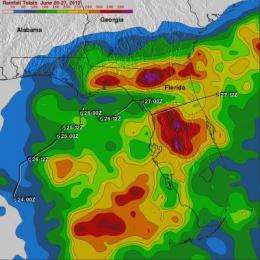TRMM Satellite measures Debby's drenching Florida rains

NASA's TRMM satellite provided data that allowed scientists to calculate Tropical Storm Debby's rainfall totals across Florida. The highest rainfall totals from June 20-27 topped 380 mm (~15 inches) in a wide patch of central Florida from around Titusville on the east coast.
Even though it never became more than a tropical storm, the residents of northern and central Florida will remember Debby. Debby, which formed as a tropical storm on the 23rd of June 2012 in the central Gulf of Mexico, took three full days to reach the Big Bend of Florida just 350 miles away. Although the center didn't make landfall until around 5 p.m. EDT on the afternoon of June 26 when it crossed the coast near Steinhatchee, Florida, Debby's effects were felt well away from the center.
Most of the rain and weather associated with Debby were well to the north and east of the center over Florida, which was effectively inundated with rain squalls originating over the Gulf and wrapping around the eastern side of the storm for 3 days. The result was copious amounts of rain over the central and northern parts of the state in addition to an outbreak of tornadoes over central and southern Florida on June 24.
In addition to capturing detailed images of tropical storms, TRMM is ideally suited to measure rainfall from space. TRMM is a joint mission between NASA and the Japanese space agency JAXA.

For increased coverage, TRMM is used to calibrate rainfall estimates from other additional satellites. The TRMM-based, near-real time Multi-satellite Precipitation Analysis (TMPA) at the NASA Goddard Space Flight Center in Greenbelt, Md. is used to estimate rainfall over a wide portion of the globe. TMPA rainfall totals are shown here for the 7-day period June 20 to 27, 2012 over and around Florida.
TRMM data showed that the highest rainfall totals for the period are in excess of 380 mm (~15 inches). The heaviest rains cover a wide patch of central Florida from around Titusville on the east coast to around Homosassa Springs on the west coast within which amounts exceed 260 mm (~10 inches) to over 380 mm (~15 inches) in the center. Another band of heavy rain is oriented east-west across northern Florida from Jacksonville to near Tallahassee with similar amounts or rain.The highest totals in the band occur around Lake City and exceed 380 mm (~15 inches). This east-west band can be attributed to the interaction of Debby's counterclockwise circulation with the coast and a frontal boundary draped across southern Georgia in an east-west orientation.
After coming ashore, Debby was downgraded to a tropical depression as it crossed northern Florida.
At 5 p.m. EDT on June 27, Debby lost tropical characteristics and became a post-tropical cyclone over the Atlantic Ocean. At that time Debby had maximum sustained winds of 40 mph (65 kmh) and it was located about180 miles (295 km) east of St. Augustine, Fla., near 29.5 North and 78.3 West.
On Thursday, June 28, 2012 at 8 a.m. EDT, the National Hurricane Center noted that showers and thunderstorms associated with post-tropical storm Debby were about 175 miles west-northwest of Bermuda. The shower and thunderstorm activity increased today and the winds are between 15 and 20 mph.Post-tropical Storm Debby continues to move to the northeast and the National Hurricane Center noted that it has a 10 percent chance of re-generating.
Provided by NASA's Goddard Space Flight Center





















